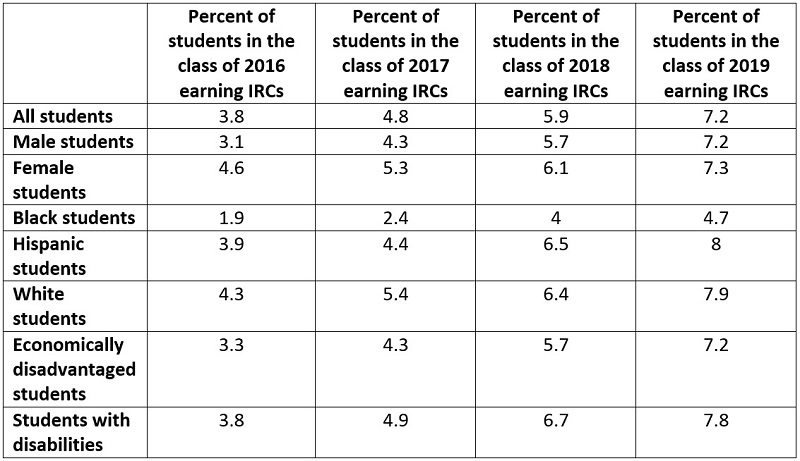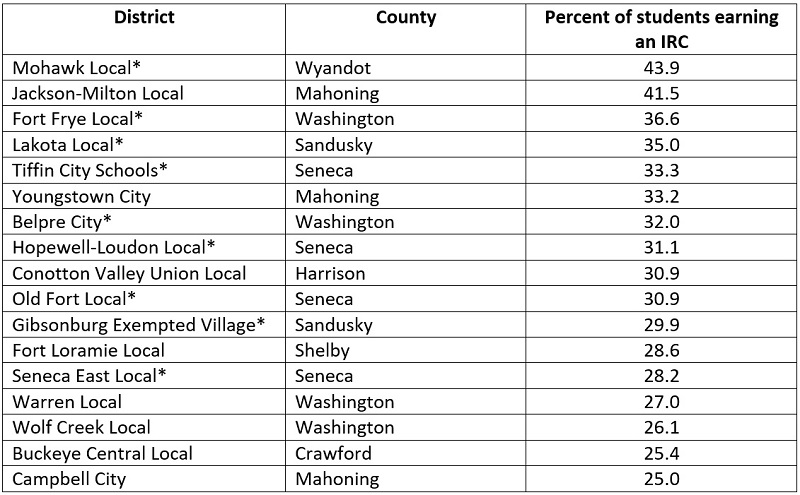In the last decade, Ohio leaders have advocated for an increased focus on career and technical education. Among the initiatives in this area is a push for industry-recognized credentials (IRCs), which verify that a student has mastered a specific skillset within a particular industry. These credentials provide a host of potential benefits to a wide range of stakeholders. They can, for example, lead to well-paying jobs for students, identify qualified candidates for employers who are hiring, and contribute to a healthy statewide economy.
To harness the potential of IRCs, Ohio lawmakers have incorporated them into several major education policies. First, IRCs are a key part of the Prepared for Success component on school report cards. As the component name suggests, it gauges how well students are prepared for success in postsecondary education or the workforce. One of the primary measures of readiness is the percentage of students who earn an IRC or a group of credentials totaling twelve “points” in one of thirteen career fields. Second, the Ohio General Assembly passed a law that allowed students beginning in the class of 2018 to meet graduation requirements by earning an IRC and meeting other career-related criteria. Although Ohio’s graduation requirements have since changed, IRCs continue to be a pathway toward graduation. It’s also worth noting that the most recent state budget established a $25 million appropriation dedicated to helping high school students earn IRCs.
Clearly, credentials are now a significant part of Ohio’s education landscape. But are students actually earning them? The most recent state report card data say yes—and reveal a steady upward trend, which indicates that policy changes emphasizing IRCs have acted as an incentive for schools to encourage students to earn credentials.
Let’s start with the state-level data. Because of the cancellation of state tests this spring due to the Covid-19 pandemic, the recently released 2019–20 state report cards lack a considerable amount of information. Fortunately, this isn’t an issue when it comes to Prepared for Success because the component relies on data from previous graduating classes that finished high school prior to the pandemic.
The table below highlights the percentage of students who have earned IRCs in each graduating class over the last four years. The biggest takeaway is that the percentage has increased every year since 2016, the first year that Prepared for Success was a graded component. Just 3.8 percent of students in the class of 2016 earned IRCs, but the total has since increased to 7.2 percent for the class of 2019. Subgroup breakdowns also reveal increases across the board. The percentage of Black, Hispanic, economically disadvantaged, and students with disabilities who earned an IRC prior to graduation has doubled since 2016.

To be clear, the overall number of students earning an IRC is still small. Only 7 percent of students in the class of 2019 earned a credential. Nevertheless, steady growth should be celebrated—especially when it occurs for a diverse group of students.
Some Ohio districts are doing especially well in regard to IRC attainment. The table below highlights seventeen districts where a quarter or more of the class of 2019 earned IRCs. Many of these districts also had high percentages of students earning credentials the previous year. The nine districts with asterisks beside their name reached 25 percent during the 2018–19 school year, as well.

As was the case with overall percentages, it’s important to put district results in perspective. Ohio has 610 traditional school districts, which means just under 3 percent of districts had a quarter or more of their most recent graduating class earn a credential. That’s a tiny number. But it is a start, and the state’s emphasis on attainment isn’t going anywhere anytime soon. It’s fair to expect that more districts will end up on this list in the future.
What does all this mean for Ohio? Well, there’s good news and bad news. The good news is that more students are earning industry-recognized credentials that could help open doors to rewarding careers. The bad news is that the state doesn’t make data on what these credentials are and whether they qualify as “high quality” readily available to the public.
Last year, The Foundation for Excellence in Education and Burning Glass Technologies released a report called Credentials Matter that offered an in-depth look at the industry credential landscape. To determine which credentials were in demand, Burning Glass used its proprietary dataset to search nearly 40,000 online job boards, newspapers, and employer sites for job postings that requested specific credentials or skills. They found that, nationally, only 19 percent of credentials earned by the K–12 students in their analysis were actually in demand by employers. In fact, of the top fifteen most commonly earned credentials, ten were oversupplied. In Ohio, specifically, more than 49,000 credentials were earned by high school students—not just those in the graduating class—during the 2017–18 school year. But fewer than 13,000 of them were considered in demand. Over 17,000 were for basic first aid or occupational safety—useful, to be sure, but not what most people think of when they think of IRCs.
Going forward, Ohio should take a few important steps to make sure that IRCs live up to their potential. The state already has a framework for determining which IRCs can be counted toward graduation and the Prepared for Success measurement, and the application process to add new credentials seems pretty rigorous. Ohio leaders deserve kudos for these guardrails and should keep them in place. But to ensure more transparency and objectivity in the process, policymakers should also work to link approved credentials to labor market outcomes, and then publish this information in an easy-to-access format that students and families can use to make informed decisions.
Ohio should also begin disaggregating credentialing data by career field or even individual certification on state report cards. The state breaks down how many students earn credentials in each district and school, and it tracks the overall attainment of subgroups from year to year. That’s a good start. But to get a sense of whether students are earning high quality credentials, Ohio should also track and publish the specific credentials students earn. Without these data, it’s impossible to know whether recent increases in attainment are actually beneficial—or just empty numbers.
Overall, Ohio has made encouraging progress in the realm of industry-recognized credentials. Attainment numbers are on the rise for a diverse group of students, and that’s good news. But to truly leverage the potential of IRCs for students, state leaders need to ensure that available credentials are linked to positive outcomes, and that those outcomes are transparent for everyone.


